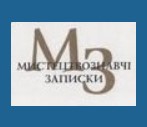ФОРТЕПІАННИЙ КОНЦЕРТ Й.Н. ГУММЕЛЯ H-MOLL OP. 89 У КОНТЕКСТІ МИСТЕЦТВА МОЦАРТІАНСЬКОГО «ЛЕГКОГО» ПІАНІЗМУ ХІХ СТОРІЧЧЯ
J.N. HUMMEL’S PIANO CONCERT H-MOLL OP. 89 IN THE CONTEXT OF MOZART’S NINETEENTH-CENTURY “LIGHT” PIANISM
Author(s): Juntao XuangSubject(s): 19th Century, Sociology of Art, History of Art
Published by: Національна академія керівних кадрів культури і мистецтв
Keywords: piano Mozartianism; pianism; "light" pianism; musical style; musical genre; concert;
Summary/Abstract: The purpose of this research is to analyse J. Hummel's Third Piano Concerto from the perspective of Biedermeier's establishments of Restoration "light" pianism, which embodied the spiritual aspirations to preserve the Rococo savings in the context of the adoption of the secularised art of the New Vienna School. The research methodology is the intonation approach of B. Asafiev school in Ukraine, which has direct analogies to the principles of Chinese musicology (see works by Ma Wei, Wu Go Ling). The specifics of the methods of historical and descriptive, musicological analytical, cultural, stylistic comparative, and interdisciplinary methods constitute the specifics of the apparatus of researching the works of the named author. The scientific novelty of the work lies in the fact that for the first time in Ukrainian and Chinese musicology, J. Hummel's Concerto is analysed in the light of the positions of Budermayer's "light play" pianism in continuation of the Mozartian line of piano creativity (according to the works of D. Androsova and L. Shevchenko) and in the development of the concept of neo-symbolism of post-avant-garde modernity according to O. Markova. Conclusions. J.N. Hummel's Piano Concerto h-moll op. 89 is marked by an impressive breadth of pianistic lyrical fioritura and the absence of theatrical drama, which corresponds to the instructions of Biedermeier, who tended to the ideal beginnings of worldview and religious humility of expression. The Concerto reproduces certain signs of Mozartian constructiveness (the second exposition with the soloist's theme, mainly the compensatory function of the orchestra), strophic expositionality that "blurs" sonata relations. The main thing is the dominant position of "piano lyricism" of ultra-fast finger movement, signs of waltzing, nocturnal, hymn-like themes in the presentation of themes that correspond to Biedermeier's mythological and religious settings, based on the crescendoing dramaturgy of increasing the intensity of movement from the beginning to the end of the concert cycle in a two-phase presentation of the energy flow in the spirit of early Christian liturgy, adopted by the salon style of Biedermeier.
Journal: Мистецтвознавчі записки
- Issue Year: 2023
- Issue No: 43
- Page Range: 194-199
- Page Count: 6
- Language: Ukrainian

